“Critical Care”
Written by Kenneth Biller & Robert Doherty and James Kahn
Directed by Terry Windell
Season 7, Episode 5
Production episode 250
Original air date: November 1, 2000
Stardate: unknown
Captain’s log. A large hospital ship sits in the sky over a planet. The ward we look in on is overworked and understaffed. Chellick, the administrator, is talking to a trader named Gar who sells him a wonderful medical device: the mobile emitter. He activates it, and the EMH is rather stunned to find himself somewhere other than Voyager.
The EMH protests that he’s been kidnapped, but Chellick just sees a useful piece of technology, especially when the EMH is unable to help himself and starts treating a patient.
Paris and Kim report to sickbay after a holographic hockey game to discover that the EMH has been replaced with a training program. We discover that Gar had come on board to trade, and got sick from something Neelix fed him and spent the night in sickbay. He obviously stored the EMH in his mobile emitter, stole the mobile emitter, and emplaced the training program in sickbay.
The EMH works on Level Red, treating patients as best he can. However, several patients don’t have a high enough TC to receive certain medications. The Allocator, the computer that controls the facility, is very strict about who can get what medications and what treatments. TC, the EMH eventually learns from Dr. Voje, another doctor assigned to Level Red, stands for “treatment coefficient.” How high your TC is depends on how much you contribute to society.
Chellick informs the EMH that he’s being transferred to Level Blue, as his obvious skill would be put to better use there. Assuming it’s an intensive-care unit, the EMH is appalled to find that Level Blue is a quieter, less crowded, less chaotic ward, with more doctors for fewer patients, many of whom aren’t critically ill. One person is receiving cytoglobin as a preventative for a minor ailment, while down on Level Red, a young man named Tebbis, who needs cytoglobin to survive, isn’t allowed it, all due to their relative TCs.
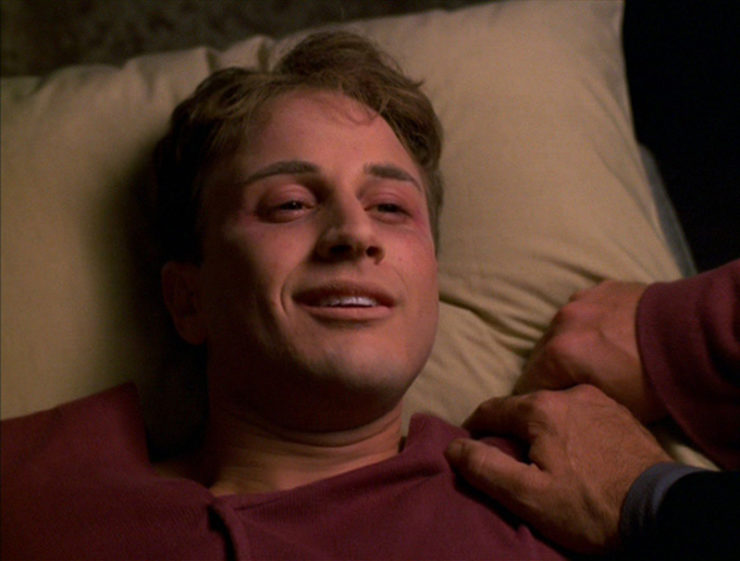
Dr. Dysek, one of the Level Blue doctors, explains to the EMH that Chellick and the Allocator have streamlined their medical facilities. Before he arrived, they were wracked with ecological disasters and inefficient healthcare. Things are much better now, he insists.
Buy the Book


A Psalm for the Wild-Built
Voyager tries to track Gar down. They trace his ion trail, but that leads to a probe emitting false readings. Gar traded iridium ore to Voyager, which has a short half-life, so he had to have gotten it from within a three light-year radius. They find a mining colony in that radius, and upon arrival find a miner angrily asking for the stolen iridium back. Janeway agrees to return the iridium (though what Voyager has is only half of what Gar stole), and the miner informs them that Gar also stole some induction units from Velos.
Upon arriving at Velos, a trader named Kipp is pissed because he gave Gar the induction units on consignment, and he hasn’t heard hide nor hair of him. Velos trusted Gar on the word of a colleague he’s known for years. Voyager meets with that buyer, whose testimonial was based on the word of his wife—who has since left him for Gar. They track down the wife, who thinks Janeway is looking to steal Gar from her. Janeway pretends to be married to Tuvok to reassure her (which nonplusses the heck out of the security chief, to the bridge crew’s amusement), and then says they have a business opportunity for Gar.
The EMH tries to convince Voje to change Tebbis’ TC to make him eligible for treatment, but when they try to add other skills to his file, it fails. So instead, he orders more cytoglobin for a Level Blue patient who doesn’t actually need it and smuggles it to Level Red. Tebbis starts feeling better, and the EMH continues to clandestinely get meds to the Level Red patients. At first, Voje refuses to cooperate—though the recovering Tebbis, who is an aspiring physician, helps out—but eventually Voje decides to risk his job to help his patients. Meanwhile, Dysek is noticing the higher treatment allocations for the Level Blue patients, and the EMH says that it’s the only way to make sure that the Allocator continues to give them enough meds for everyone. If they use too little one month, the next month’s supply will be far lower.
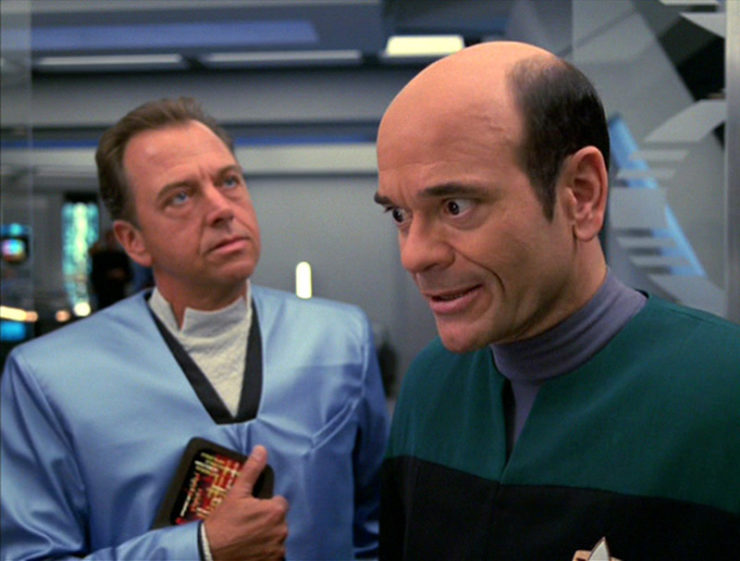
Gar protests his innocence when Voyager finds him, and in response, Janeway beams him to the brig. Tuvok and Neelix both try to intimidate him, Tuvok by threatening a mind-meld, Neelix by giving him poisoned food (though it only gives him gas, not the life-endangering stomach bug that Neelix describes, that can only be treated by the EMH).
Chellick finds out what the EMH has been doing, and starts discharging patients whose treatments aren’t finished, because they’ve gotten more than their allocation of meds. Tebbis also dies when he’s denied his meds. The EMH is devastated. Chellick then interfaces the EMH with the Allocator so that he can only go where the Allocator sends him.
While the EMH’s movements are now restricted, his interface with the Allocator allows him to have the computer summon Voje to Level Blue. Voje is stunned—he’s never even seen Level Blue—and is conscripted by the EMH to smuggle his mobile emitter to Level Red. Once there, Chellick, of course, follows, and the EMH injects him with the same virus Tebbis had. What’s more, the Allocator identifies patients by blood factors, and the EMH’s injection also makes Chellick seem like Tebbis to the Allocator. Chellick is now violently ill, but because the Allocator thinks he’s Tebbis, it won’t authorize the medication.
Voyager arrives at the hospital ship. Torres can’t beam the EMH out because his program is interfaced with the Allocator. Attempts to communicate fail because only Chellick is authorized to speak to anyone outside the hospital, and he’s indisposed. So Chakotay and Torres beam to the ship. The EMH puts off his rescue long enough for Dysek and Chellick to come to an arrangement where some of Level Red’s most critical patients are transferred to Level Blue—including Chellick.
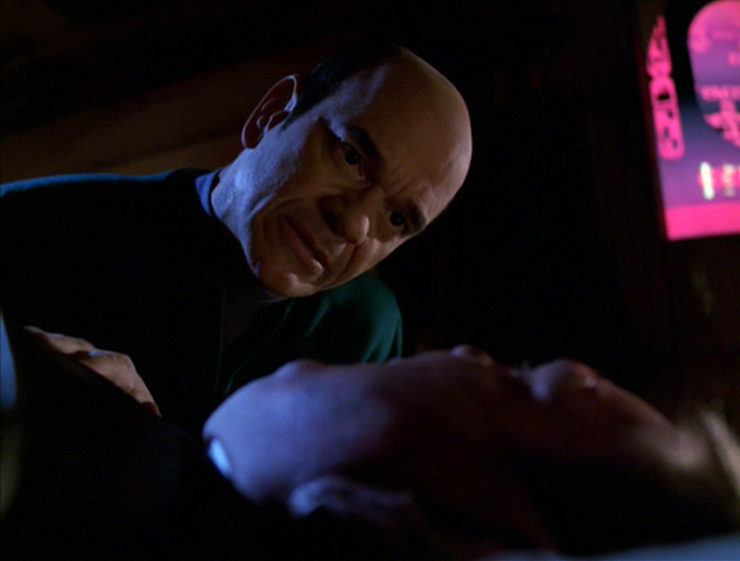
After being restored to Voyager, the EMH asks Seven to examine him to make sure he’s functioning right. He thinks his ethical subroutines may have been compromised by the interface with the Allocator, given that he deliberately poisoned a healthy person. But Seven assures him that he’s functioning normally.
There’s coffee in that nebula! Janeway gets ever-more-frustrated with Voyager’s jumping from victim of Gar’s mendacity to victim of Gar’s mendacity, culminating in an epic “are you fucking kidding me?” expression on Kate Mulgrew’s face by the time they get to the woman who left her husband for Gar.
Mr. Vulcan. Tuvok does excellent work in tracking down Gar, being his usual methodical self working his way to finding him.
Everybody comes to Neelix’s. Neelix is worried that he himself was responsible for Gar stealing the EMH, as he added spices to the dish he fed him that Gar was susceptible to. Janeway assures him that food poisoning doesn’t turn someone into a thief, and he would’ve found another way to get what he wanted.
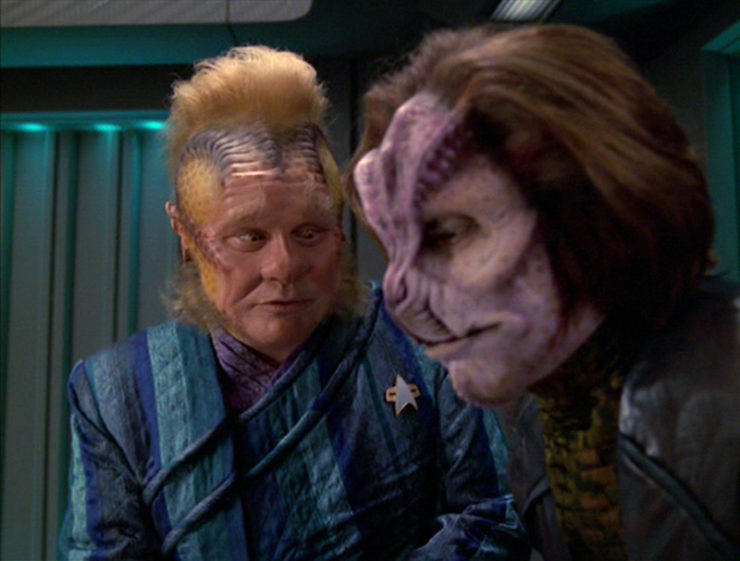
Half and half. Torres tries and fails to beam the EMH out of the hospital ship. Presumably, she is able to untether him from the Allocator on site…
Please state the nature of the medical emergency. The EMH is unable to help himself from treating the sick on Level Red even though he’s been kidnapped. Nor is he able to help himself from trying to heal everyone no matter what…
Resistance is futile. When the EMH explains what he did in the hospital, Seven says, “You were prepared to sacrifice an individual to benefit a collective,” to which the EMH angrily replies that he doesn’t exactly aspire to Borg ideals…
No sex, please, we’re Starfleet. Tuvok is obviously put off when Janeway grabs his hand and announces that she and he are a happy couple, but he still is able to help get the information they need.
Do it.
“Because you performed so efficiently last month, the Allocator will determine you’re able to do with less next month. If we don’t order more medication now, we may not get it when we need it. Think about it, Doctor. If you don’t have the proper resources, your cure rate could go down. If that happens, the Allocator may assign you to a lower level.”
“Are we having a problem with our newest piece of technology?”
“Actually, he seems to be learning the system quite well.”
–The EMH telling Dysek how to game the system, Chellick interrupting, and Dysek admiring the EMH’s mendacity
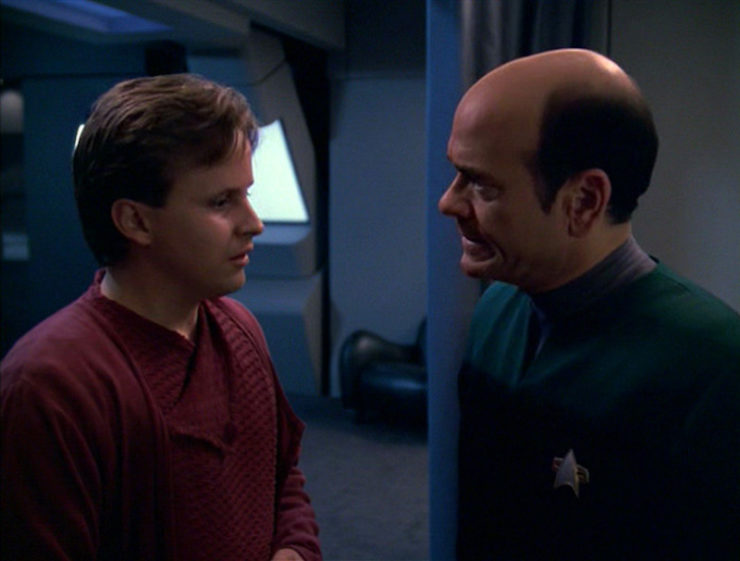
Welcome aboard. Trek veterans Gregory Itzin and John Durbin are in this one as Dysek and the miner, respectively. Itzin previously appeared in DS9’s “Dax” and “Who Mourns for Morn?” and will appear twice on Enterprise in “Shadows of P’Jem” and “In a Mirror Darkly, Part II.” Durbin was on TNG’s “Lonely Among Us” and both parts of “Chain of Command,” and also was in DS9’s “A Simple Investigation.” Debi A. Monahan, last seen as Melissa in DS9’s “His Way,” plays Gar’s new girlfriend.
John Kassir plays Gar, Paul Scherrer plays Voje, and Dublin James plays Tebbis. Other hospital staff are played by Christinna Chauncey and Stephen O’Mahoney, while other folks Voyager interviewed on their way to finding Gar are played by Jim O’Heir and John Franklin.
And we’ve got two Robert Knepper moments in this one. First there’s Larry Drake, best known prior to this for his Emmy Award-winning role as Benny on L.A. Law, as Chellick, and also the voice of KITT from Knight Rider, William Daniels, as the voice of the Allocator.
Trivial matters: This is the first Voyager script by James Kahn, who joined the staff as a supervising producer for the final season. He previously co-wrote TNG’s “The Masterpiece Society.” In addition, he wrote the novelization of Star Wars: Return of the Jedi.
The EMH expresses concern that his ethical subroutines have been compromised, which has already happened twice before, in “Darkling” and “Equinox, Part II.”
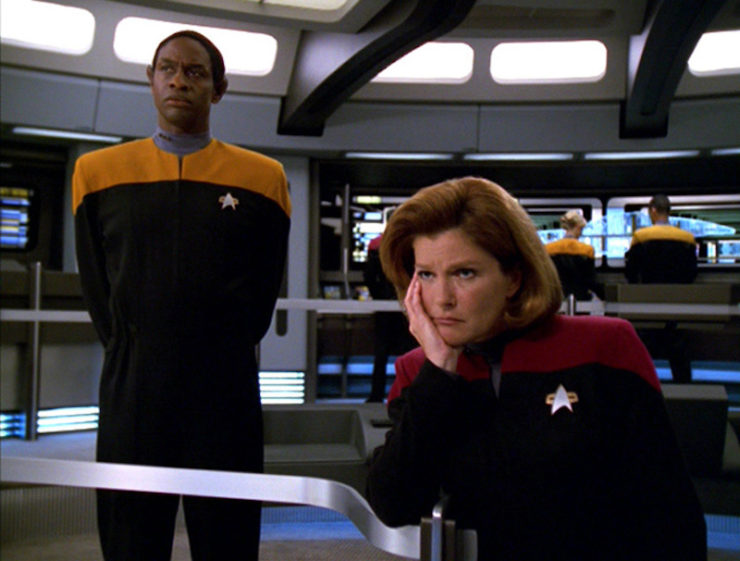
Set a course for home. “That feeling you get from helping someone—infectious, isn’t it?” Star Trek is well known for its tendency toward social commentary, and this is a particularly unsubtle—but also successful—example of that. The issue of healthcare resource allocation is one that was very timely when this episode aired in the United States at the turn of the millennium—a decade after the Clinton Administration’s failed attempt to get some manner of universal healthcare in the U.S. and a decade before the Obama Administration would pass the Affordable Care Act—and it’s one that still resonates in 2021 as we find ourselves still mired in the grip of a global pandemic.
The primary appeal of the episode—as usual—is Robert Picardo. He shines as always, showing the EMH’s snarky compassion and dedication to the healing arts regardless of the circumstances. I particularly like how he objects to being stolen but the nanosecond there’s an obvious medical issue, he jumps right in.
The ending is a much more clever telling of an AI moving past his programming than the ending of TNG’s “The Most Toys,” which was a bit mealy-mouthed about the whole thing. The EMH has grown and developed over six-plus years of constant activation, and while Seven’s Borg-like comment that he sacrificed an individual for the good of the collective (because saying the needs of the many outweigh the needs of the few would be too obvious, I guess) appalls him, it’s also true. He was serving the greater good, and there’s also the fact that even so hidebound a bureaucrat as Chellick would have enough of a self-preservation instinct to get himself treated.
All the guest actors do quite well, also, though Paul Scherrer and Dublin James are both baby-faced white guys with similar voices, and it’s sometimes hard to tell them apart. Still, they all comport themselves well. I especially like Gregory Itzin’s subtle portrayal of Dysek. Both Voje and Dysek need the reminder from the EMH—who literally has the Hippocratic Oath programmed into his brain—that the patients should come first. Voje’s cynicism and desperation is more obvious, but Dysek is just as tired of the bullshit, and he also uses the EMH’s idealism for his own purposes. And Larry Drake is, typically, superb. It would be easy to play Chellick as an over-the-top bad guy, but Drake sensibly plays him with a bland, bureaucratic affect—banal, reasonable evil is way way more scary than cackling diabolical evil.
On top of that, the cuts back to Voyager as they try to find Gar are delightful, especially the expression on Kate Mulgrew’s face when Janeway has to deal with yet another person who isn’t Gar…
Having said all that, the episode doesn’t quite commit to dealing with the issues as strongly as it can. Chellick’s solution is extreme, yes, but it was also necessary. In the abstract, the streamlining and prioritizing is important for a society that has limited resources, something the EMH—who comes from a replicator-based society—would struggle to even understand. (Especially given how half-assed Voyager’s own supply issues have been during their sojourn.) Still, it’s a strong enough allegory, and full of enough great performances, that it stands out as one of Voyager’s finest hours.
Warp factor rating: 9
Keith R.A. DeCandido is also reviewing the new season of Star Trek: Lower Decks on this site. Check out his review of the second-season premiere, which should be appearing today on the main page…










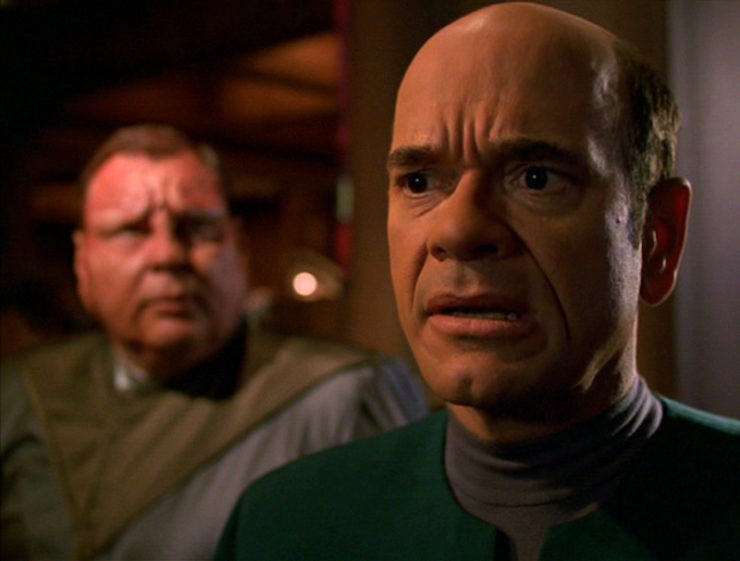
This is one of my favorite episodes, but it is still cut off at the knees by the way the show never let the ship run out of supplies, fuel, or personnel.
This could have been amazing if it had included callbacks to one of the other great Doctor-focused episodes: Latent Image
Triage is something the EMH is (or should be) very familiar with, and that’s what he’s dealing with here: Triage on a societal level.
I definitely liked that the ‘villain’ wasn’t some moustache-twirling capital-E Evil character, but rather a cog in an evil machine. But I do wish the scenario wasn’t quite so obviously Wrong that the conclusion was inevitable.
Maybe by making the Blue level a little less cosmetic and the Red level a little less critical, they could have introduced a scenario where the bad guys were only 75% wrong instead of 100% wrong.
I thought it was an okay episode. It had all the subtlety of a two-by-four to the head. In case we weren’t sure whose side we were supposed to be on, the antagonist was an ugly, fat guy who takes his orders from a computer (a classic Star Trek trope), while the good guys were all good-looking actors straight out of central casting. This was the first of two obvious social allegories we got this season (the other being “Repentance”). We get it: HMO’s = bad.
I did have to wonder about how injecting Benny with a vial of the other character’s blood would suddenly cause the computer to identify Benny as the other character. Presumably, most of his blood would still be his own.
I was sorry to learn that actor Larry Drake died a few years ago. He was absolutely fantastic as Benny on L.A. Law. As Keith pointed out, he was a multiple-time Emmy winner. His performances ranged from heartbreaking to amusing. As far as other L.A. Law actors who also appeared on Star Trek, among the main cast, I can only think of Corbin Bernsen (who was a Q in “Deja Q”) and Diana Muldaur (Dr. Pulaski). Also, Michael Cumpsty (Lord Burleigh on Voyager) appeared for one season on L.A. Law as a sleazebag lawyer.
@1 AGrey: Maybe by making the Blue level a little less cosmetic and the Red level a little less critical, they could have introduced a scenario where the bad guys were only 75% wrong instead of 100% wrong.
Yeah, I think you’ve keyed in on the flaw in this episode. The writer, the showrunner, the executives– somebody– wanted to make sure nobody could possibly side with the antagonists, so they stacked the deck. The Doctor is quite right to point out his patient is a child, so there’s no telling what he’ll accomplish.
But with rare exceptions, we have a pretty good idea at 30 years old and a near definite idea at 40 years old (adjusted for their version of 30/40). They’ll likely go on to do decades more of whatever it is they’ve done up to this point, more or less. What if the patient on red level is hardened criminal? Suddenly extending his life at the expense of the chief engineer of an irrigation facility doesn’t sound like such a great idea. What if the patient is, well, not exactly a hardened criminal, but just kind of useless? Save his life today, and thousands may starve twenty years from now when the irrigation engineer has a heart attack and therefore the crops fail. Multiply that at a societal level, and it starts to look downright irresponsible to *not* allocate care with an eye towards what society is likely to get back out of this investment.
There’s a smart story in this premise somewhere about a society making some very difficult choices, but this wasn’t it.
I agree with the commentary on nuance and the further conversations that could be had about how societies prioritize. I think there was more than they intended, though. They actually do highlight the fact that in no system is healthcare “free” or “unlimited”. You will always have a bottleneck. This could be from medicine, equipment, or qualified labor. We’ve seen this with Covid – sometimes there were shortages of PPE, sometimes ventilators, sometimes anti-viral drugs, sometimes vaccines, and sometimes simply beds and doctors/nurses. In this society the medicines seemed to me to be in abundance but space and qualified healers are the shortage. Some societies handle this shortage by what they charge for more intensive procedures. Others employ a sort of social credit to determine who gets priority, and that appears to be the route this species went.
Huh, I never really loved this one. I always thought a far more interesting plot would have had there actually *be* a shortage of critical medication, and hence an actual reason for the Allocator, and there doesn’t seem to be one. They have enough medicine that they are essentially wasting it on marginally effective preventative procedures. Sure, that would have taken away from the ham-fisted metaphor of American health care, but I think it would have made for a better story. Voyager too often took the track (IMO) of discovering an easy option out of a complicated moral question- and they do the same thing here. It isn’t that there isn’t enough to go around, just that they have a dumb system. And don’t get me wrong, that is accurate to real life, but “accurate” and “interesting” are not always the same thing. I would have liked to have seen this as a spiritual sequel to the EMH’s struggles in “Latent Image”- just on a larger scale. What do you do when there just genuinely isn’t enough to save everyone- who do you chose, and based on what? Do you prioritize the young? The old? The most “useful”? The most politically and socially powerful? There’s a lot there to work with, and the episode cruises by all that in favor of WINK WINK NOD NOD ISN’T THIS A SILLY SYSTEM WE’VE GOT HERE?!?!
All that said, it isn’t a bad episode. Picardo is a delight, as ever, and the Janeway-Tuvok scene was more than worth the price of admission (Prophets bless Tim Russ and his facial expressions). I just wanted something more out of the episode that wasn’t there.
Delurking after all these years simply to say that I was highly disappointed when my initial thought that Dysek was being played by Ray Wise was dashed within seconds.
Bill: out of curiosity, why did you think he was being played by Wise?
—Keith R.A. DeCandido
This is honestly one of my favourite Star Trek “message” episodes; and I think it’s been a long time since the writers have worn their position so blatantly on their sleeves.
I disagree with the critiques of the episode’s portrayal of the health care system. There’s nothing wrong with portraying it as fundamentally unjust, because that’s what makes it work as a commentary on the United States’s fundamentally unjust health care system, which has only gotten worse in the decades since. Heavy-handedness is not automatically a sin, not when the subject matter warrants it.
Okay, maybe the Allocator’s excuse of “value to society” sounds superficially more reasonable than “making insurance company CEOs even richer,” but value by what standards? What parameters is the Allocator using to define relative worth? Just because it’s a computer doesn’t make it fair. Computers are only as good as the data they’re fed, and we’ve seen news reports in real life about machine learning systems jumping to racist or sexist conclusions because of unexamined racial or gender biases built into the data they’re given and the models they’re programmed with. So we should be skeptical of any system that claims it can define some people as having intrinsically greater worth than others.
After all, the so-called “limited resources” here seemed to be unfairly allocated instead. As with most forms of perceived scarcity in the real world, it’s not actually that there’s not enough to go around, but that the group with higher status is hoarding more than it needs and leaving the rest to go without, like with the cytoglobin.
The show’s grasp of chemistry remains problematical. Iridium ore would not have a half-life, short or otherwise; both naturally occurring isotopes of iridium are stable. All its radioisotopes are synthetic; obviously something with a short half-life would not be found in nature because it would’ve long ago decayed. So even if they’d made up an imaginary name rather than calling it iridium, the idea of ore with a short half-life is a contradiction in terms.
Thank you Mr. Bennett for pointing out that on-the-nose isn’t inherently a bad thing. The modern sensibility (and by modern I mean like in the last 10 years, basically since Game of Thrones changed television) is that gray=good writing, black and white=bad writing. Sometimes the story is just “This aspect of humanity is messed up isn’t it? Let me show you how.” An allegory doesn’t need to be delicately nuanced and “fair and balanced” to be effective. Star Trek in particular has never been very subtle with its message episodes and yet there are several that rank among the best stories in the franchise.
Also thanks to Mr. Bennett for confirming my suspicion that iridium isn’t an unstable ore. I was pretty sure that made no sense.
I did always like this one. Maybe the best scene is the last one. Many times in fiction about heroes and morally solid people the effects of their less-than-pristine deeds are glossed over. The Doctor showing real remorse for essentially breaking his base programming and making a healthy man sick was exactly what he would do, it’s just not always something we actually see.
@10/eric: Oh, the idea that moral ambiguity and darkness make good drama is much older than Game of Thrones. I’d say it first started to kick in around the ’80s.
I’d say moral ambiguity and darkness kicked in much earlier than that. Film noir, anyone?
“Level Blue is the area where it’s most critical that we provide excellent care.”
It’s hard to say which real-life medical system this most reflects (a review in a UK genre mag described the system as “part-NHS, part-Bupa”) and maybe that’s the point, the themes are universal, except in this show. It’s a culture shock for the Doctor to go from the egalitarian Federation to a society where the haves get better medical treatment than the have-nots, just as it’s a shock for the viewer when what initially seemed to be an overrun, dirty, badly resourced hospital turns out to have a pristine and luxurious ward that the lower classes don’t have access to. The Doctor does his best to play the system and it’s interesting to see the differences approaches he uses with the characters he encounters. With Voje, he appeals to his compassion. With Dysek, he appeals to his practical side and the need to keep resources for his department. In the case of Chiellick, only the threat of death moves him to change his mind, a fact that weighs heavy on the Doctor’s conscience during his last conversation with Seven. It’s unclear whether any of this will stick though, or if the next group of patients will be dealt with like they were before once the Doctor’s gone.
Neelix basically replays his trying-to-make-up-for-being-a-schmuck arc from “Live Fast and Prosper”: I remembered the scene of him and Tuvok trying to out-bluff Gar but not the set-up. The plot thread of Janeway retracing her way through Gar’s previous victims is quite fun and Paris and Kim’s reactions to her pretending she and Tuvok are a couple are priceless.
@krad – just as he came on the screen, I thought it looked like him and got excited. I quickly realized my mistake.
@12/G.Spiggott: Sure, but I was talking about the trend in television. In the ’70s and much of the ’80s, TV heroes tended to be clean-cut types who could do no wrong. Eventually there was a backlash against that and TV protagonists started getting more flawed and ambiguous.
Although I could go much further in the other direction too. Plenty of moral ambiguity and flawed protagonists in Shakespeare, say.
Sure moral ambiguity and flawed heroes is not a new concept, it just seems to me that the last decade has tipped the scales from more easily-defined morality and unimpeachable heroes. Maybe 20 years. But even early versions, like, off the top of my head, Firefly which had flawed protagonists, they were more rough diamonds than Jamie Lannister types. Mal Reynolds is not going to stab anyone in the back, unlike a lot of our more recent main characters. And it seems like tv is a lot more willing to give us actually sympathetic villains. Again, there’s a difference between Jamie Lannister and the typical genre antagonist. Most of the time we weren’t supposed to sympathize with a guy who introduced himself by paralyzing a child in an attempt to kill him.
What I mean is there have always been examples of moral ambiguity and characters that don’t stick entirely to their proscribed roles, but it used to be an outlying trend. Now it’s like we expect a deep dive on the complexities of human morality in everything and are disappointed when something is straightforward.
@16/eric: I think it’s apples and oranges to compare a premium-cable show like GoT to a commercial-network show like Firefly. Premium shows have always been able to get a lot darker and edgier than commercial shows, since they’re aimed at more of a niche audience. The comparison for a show like GoT would be something like The Wire from 2002 or Spartacus from 2010.
(15,16)
I see, sorry, I misunderstood.
To be fair, that’s how Jaime Lannister was written in the novels.
I really like what they did with Dysek. The way he looks at Voje after the latter says “I’m sorry, I had to tell him…” sure sounds to me like he’s saying “Hey, don’t worry, I’m with you and the Doctor here.”
I’m glad to see I wasn’t the only one who thought Voje and Tebbis resembled each other to a distracting degree. It might have made for some additional interesting drama had the two characters been related, and it would have explained the resemblance. I thought the episode was pretty tightly written, though, so I don’t know how they would have worked that in if they had decided on a last-minute addition to the script.
Somehow I never cottoned on to the fact that William Daniels was the voice of the Allocator. He has a pretty distinctive voice, and I watched Knight Rider when it was on, so I don’t know how I missed it.
I’m mildly surprised you didn’t highlight John Kassir in the Robert Knepper moments: he played the Crypt Keeper for several years on “Tales From the Crypt.”
William Daniels and Knight Rider have been mentioned a couple of times now, but no mention of Boy Meets World? Really?
I suppose casting William Daniels as the Allocator was a nod to both of his most famous roles, a doctor in St. Elsewhere and an artificial intelligence in Knight Rider.
@23: Daniels was also the president of SAG when this was shot and aired. I don’t think that had anything to do with how he was characterized on Voyager, I just like to make a note of when awesome people are also big union supporters.
@9
> Okay, maybe the Allocator’s excuse of “value to society” sounds superficially more reasonable than “making insurance company CEOs even richer,” but value by what standards? What parameters is the Allocator using to define relative worth? Just because it’s a computer doesn’t make it fair. Computers are only as good as the data they’re fed, and we’ve seen news reports in real life about machine learning systems jumping to racist or sexist conclusions because of unexamined racial or gender biases built into the data they’re given and the models they’re programmed with. So we should be skeptical of any system that claims it can define some people as having intrinsically greater worth than others.
Isn’t that the dilemma the Doctor faced in Latent Image? That he, as a machine, was fallible – and let sentiment prioritize one life over another?
My problem with the episode is that it falls so far on the side against “inequitable care is bad and valuing the discomfort of some over the lives of others is bad” that it lands in the realm of “triage is bad” – that the writers gave us a scenario so hopelessly evil that it almost ceases to reflect the system it’s supposed to be criticizing. They’re using a drug that could save one life, and giving it to someone else to reduce their risk of heart disease by 1%.
The Doctor has had to make tough calls where the life of one patient must be prioritized over the life of another. And sometimes, he’s gotten it wrong. That’s not evil, it’s the unfortunate reality in a scenario where medicine and medical expertise are insufficient to meet everyone’s needs. It’s too bad the episode forgot to bring that experience to the discussion.
Again, I do really like this episode – the message isn’t a bad one, and the acting is fantastic. It just feels less like sci-fi social commentary and more like a political cartoon.
@25/AGrey: “Isn’t that the dilemma the Doctor faced in Latent Image? That he, as a machine, was fallible – and let sentiment prioritize one life over another?”
No, that’s completely and utterly different. For one thing, that choice was between two people whose lives were equally in danger, while this is about letting “less valuable” people die of curable conditions so that “more valuable” people can be slightly less inconvenienced by their non-fatal conditions. For another, the distinction here is not personal sentiment toward an individual but cultural bias about one entire class of people being intrinsically “worth more” than another based on what might well be arbitrary or elitist standards. The AI nature of the decider has no bearing in either case, since a living doctor faced with the situation in “Latent Image” might have made exactly the same choice for the same reasons (indeed, that was essentially the point), while a computer like the Allocator or real-life machine learning systems can inherit the prejudices of the society that programs it.
“My problem with the episode is that it falls so far on the side against “inequitable care is bad and valuing the discomfort of some over the lives of others is bad” that it lands in the realm of “triage is bad” – that the writers gave us a scenario so hopelessly evil that it almost ceases to reflect the system it’s supposed to be criticizing. They’re using a drug that could save one life, and giving it to someone else to reduce their risk of heart disease by 1%.”
That doesn’t make sense. As I just said, the whole point is that it’s not a triage situation because it’s not equally life-and-death on both sides. So it doesn’t even remotely suggest that triage is bad — only that the system is corrupting the concept of triage as an excuse for its biases. Condemning the corruption of a concept is exactly the opposite of condemning the concept itself.
I’m divided on this one. On one hand, it’s a well written vehicle for the EMH, bringing out the best in him. It’s a biting commentary on healthcare – as relevant now as it was 20 years before. And it portrays quite the complicated and interesting group, giving a lot of nuance and variety to the usual predictable and stale Delta Quadrant (this is definitely Itzin’s best performance across his multiple Trek roles). A lot of the credit obviously goes to James Kahn and his experienced background – he’s worked on medical shows before.
But Voyager was in the unfortunate position of being a show that aired at the same time as ER – back when that show was still the undisputed king of hour-long network drama, both visually and narratively. And to me, a lot of the episode’s trauma scenes feel hopelessly derivative – it feels like it’s trying way too hard to mimick ER. Plus, a lot of it pales in comparison to DS9’s superior Nor the Battle to the Strong. But it’s still a welcome step up from TNG’s Ethics and that episode’s poorly staged trauma set piece. Kudos to Windell for not making it boring (and I liked the visual effects quite a bit on this one).
An earlier claim to fame by William Daniels was his role in the original 1776 Broadway show (and later movie) as John Adams, a role that Brent Spiner played in the 1997-1998 revival.
I would think that if you want to write a critique of American healthcare – or anything else – the first requirement is to understand it and accurately depict it and its failure modes. This system seems far too centralised and coherent to work as a depiction of American healthcare industry. It sounds a bit more like Britain, where the centralised NHS decides whether a treatment is cost effective for a patient, and does not provide it if the answer is no. But you can get any treatment privately if you are prepared to pay up:
National Institute for Clinical Excellence
To complain about Evil Insurance Companies refusing to pay for less cost-effective treatments is to demand they let more people die or raise their prices.
@29/ad: Fictional allegories aren’t required to be exact duplications of the things they’re commenting on. Indeed, that’s generally undesirable because it’s too blatant and artificial, as well as unimaginative. What you want is not merely a lazy copy of the real thing with the serial numbers filed off, but something that’s creative in its own right and plausible within its fictional context, while still evoking the ideas you want the audience to think about.
@30 I won’t disagree, but if you want to criticise how something X acts you have to show, at some point, how it acts.
BTW – It occurs to me that the EMH was probably treating many more people aboard the hospital ship than aboard Voyager, so if equal treatment is such a thing, maybe he should have stayed there to treat more people.
@29
That’s not <I>really</I> analogous to what NICE does, though. They’re deciding if treatment is worth authorising for *any* patient, given their budgetary constraints. They don’t sit there going, well, we will authorise this medication for X because they perform vital work for the community, but deny it for Z because they failed their GCSEs and are only interested in gaming.
Indeed, while this is getting off topic, the bread and butter of privatised medicine in the UK is not “getting people life-saving treatments they can’t get on the NHS”, it’s “letting people have their knee replaced a bit quicker.”
@29, the Allocator here is not a stand-in for NICE, protecting the NHS budget – it’s more of an extrapolation of what would happen if their calculations were based on some formula of “worth to society” rather than the “quality-adjusted life years” formula which doesn’t take external factors like occupation or skills into account at all, and should never be used to justify withholding a treatment which would save a person’s life and lead to a full recovery, as the cytoglobin injections are implied to do for Tebbis and the other Level Red patients.
@29, 32 et al: Yes, quite, the whole ethos of the NHS is “free healthcare for all”. The situation as presented in this episode is pretty much the reverse of the way the NHS works: No NHS hospital would let a patient die because they’d rather give the medicine to a patient who won’t die today but might die in a few decades’ time. So, if we’re looking at an exact analogy, then the NHS is about as far away as you can get.
Of course, as has been discussed, the analogy doesn’t have to be exact: It’s just an allegorical way of commenting on the fact that any health care system is biased towards those who can afford more medical insurance, or who can afford to go to a private hospital rather than spending months or years on an NHS waiting list.
Is there any reason why the EMH “training program” seen here wasn’t used during previous instances when the Doctor was away from the ship (“Life Line,” “Message in a Bottle”)? Besides the fact that the idea for it was not developed until this episode. If anything, it would have prevented that terrible scene in “Message in a Bottle” when Harry and Tom try to program a new EMH.
@36/bgsu98: They don’t actually call it a “training program.” The exact line is “The program running in sickbay is from one of the Doc’s old training files.” It appears to be nothing more than a recording being played back.
The big Robert Knepper moment from me was Jim O’Heir as the cuckolded husband. That would never happen to Garry Gergich from Parks and Rec!
Oh wow, thanks for this! No wonder he looked familiar :)
It’s interesting how increasingly a lot of older comments and reviews reflect a misled American public. The drug companies COULD produce plenty of what is needed and charge reasonable prices. America COULD provide free healthcare without a burdensome cost. However, simple greed prevents them from doing so. This is why the satire is not nuanced because there IS no nuance.
I like how even the rich Level Blue Doctor is disgusted by this to an extent. He undoubtedly prefers being paid better and working in less than terrible conditions but he still doesn’t want people to be left to die because they can’t afford medicine. My only real regret about this episode is that they use the Allocator and resource scarcity as an excuse versus just saying “money. These people can’t afford it.” There’s no reason not to have it be a paid-for medical society.
And yes, I think they could and should embrace a 100% “this is wrong in RL and on the show” attitude.
I’m surprised with how well this episode dealt with its subject matter. An obvious allegory, sure. But one that’s handled with a decent amount of subtlety, crisp direction, and a ruthlessness that Star Trek doesn’t often allow. They could have gone to something like having the administrator’s own kid being sick and on the brink of death, but instead they have the doctor practicing dark medicine and malicious compliance.
It’s just a good example of finding a subject and mining it for its best opportunities. And for what it’s worth, which isn’t much, this one is a 10 for me.
Also, I’m in total agreement with CLB. It is fundamentally unjust.
And it’s going to get worse. When this show aired — and when the rewatch was written — AI hadn’t yet been built into our healthcare system. I think this episode gets more prescient all the time.